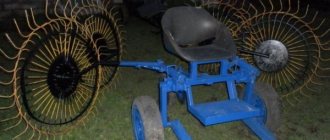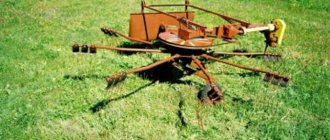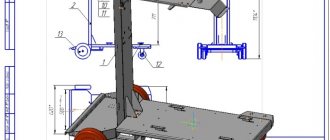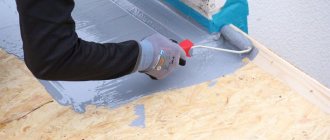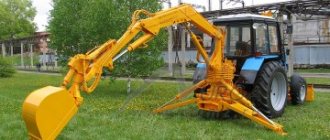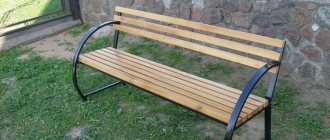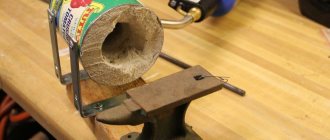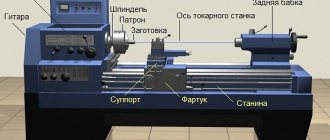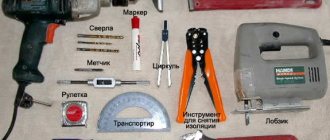DIY tedder rake
Rakes are an indispensable tool in almost all types of agricultural work.
In the past, they were the main tool for hay harvesting, which was carried out in two stages. First, the grass was mowed by hand, then collected into windrows using a rake. This method of preparing feed for livestock was very labor-intensive. Nowadays, all these actions are performed by one unit - a rake-tedder. With their help, machine operators rake the mown grass, turn it to dry and collect it into windrows. If farmers and summer residents in small areas quite successfully cope with such work with the help of ordinary rakes, then in large areas they cannot do without tedders. DIY tedder rake
Features of equipment designs
According to the model type, tedder rakes can be used on tractors, mini tractors and walk-behind tractors. During operation they are operated by one person. According to their technical characteristics, they are classified according to the following parameters:
- By type of traction they are divided into tractor (for tractors) and horse-drawn (for walk-behind tractors);
- according to the method of collecting hay in windrows - transverse and lateral;
- by design (geared, wheel-finger and drum);
- according to the method of attachment to the equipment.
Due to its shape and appearance, the structure is called the “sun” due to the similarity of the rotor tubes to the sun’s rays. There are many models of tedder rakes in factory production, but the most popular are rotary and wheeled.
Rake tedder 5 wheels
Rotary rakes are designed in such a way that their basis is one wheel with rotor pipes, on which pin tubes are secured with springs. With the help of these devices, types of work such as tedding and drying grass are carried out. But they are not suitable for windrow collection. The rake is mounted on wheeled tractors and operates using the machine's hydraulic system.
Wheeled tractor tedders are a model consisting of several (4-5) “floating” wheels mounted on a suspension. This type of design makes it possible to work on fields with different terrain. Rotary and wheeled tedders can be used on all types of agricultural machines. Therefore, they often make roller rakes with their own hands.
Interesting. Replacing manual labor using simple rakes with mechanical tedders allows you to increase efficiency tenfold.
Operating principle and design features
In order for mounted rakes to work properly, it is necessary to select equipment based on the traction class of the tractor. The most popular models are designed to work with mini-tractors; therefore, they do not have a wide coverage and are suitable for use in small areas.
With heavy tractors it is advantageous to use wide-cut equipment. If you do not take these nuances into account, you will not be able to achieve maximum efficiency of the unit.
Wheel-finger rake GKP-6.1
Mounted rakes can consist of one or several sections. Almost all models have their own wheels and, accordingly, belong to the category of semi-mounted equipment.
It is worth noting that usually the drive goes to only one wheel. The position of the frame is changed by adjusting the drive wheel. Sections with steel teeth are attached to the frame.
They are the working part of the equipment.
The teeth are made of high-strength material, so they do not suffer mechanical damage even when colliding with stones or debris.
Depending on the design, hay rakes can be divided into three groups:
- Rotary. Perhaps these are the most expensive models on the agricultural equipment market. Rotary rakes are quite functional: they can not only turn up the grass, but also form windrows. It is worth noting that almost all models can operate in automatic mode.
- Wheel-finger. This equipment can only be used for dry beveling. This is the only drawback of the product. Thanks to a well-thought-out design, wheel-finger units show good performance and are rightfully considered the most practical products.
- Transverse. The simplest units in terms of their technical characteristics. Such rakes do not stir up the bevel, but only rake it into windrows. The performance of the equipment directly depends on the width of the area covered and the power of the tractor. The one-sidedness of the work is compensated by the low cost of the equipment.
The principle of operation of the design
The operation of the equipment is based on the transmission of the rotational motion of the tractor or walk-behind tractor engine to the rake mechanism. This allows you to use up to five pairs of wheels and carry out hay harvesting over a large area. Using special devices on wheels that resemble large hooks, you can perform several types of work: prying up armfuls of grass or shocks of straw, turning over or raking.
Everything will depend on the setting of the angle of the needle wheels. This will allow you to combine or vary the functions of the machine. You can set the rake so that it collects grass in the center or, conversely, arranges it in a row to collect hay from the front. Thanks to the simple operating principle of the unit, it will be easy to work with. Therefore, it will not be difficult for a self-taught craftsman to make a homemade rake for harvesting hay for a tractor with his own hands.
Mounted tedder rake
Characteristics of attachments for walk-behind tractor
This type of device falls into the category of attachments. The rake is attached to the walk-behind tractor using an adapter. This is convenient, as it allows you to use various equipment on one walk-behind tractor. Very often one or more types of rakes are already included in the kit. However, there is also equipment where the package does not include any attachments. These options are cheaper. But you need to take into account that you will either have to buy the additions or do it yourself, using pre-prepared drawings.
Most walk-behind tractors have the ability to raise or lower the rake using a handle. This is convenient and allows you to carry out work and clean the device more efficiently.
Regardless of whether it is a homemade rake for a walk-behind tractor or a purchased one, it must be durable. Most often, manufacturers make such equipment from high-quality steel. It should have excellent anti-corrosion properties, since the rake will often come into contact with water. This is the option that will last a long time. Steel attachments do not bend or rust, so they can be used for more than 10 years. The service life of the device largely depends on the storage location. Any attachments must be kept in a dry room. After use, the rake must be washed and dried.
Technical capabilities of the device
The most important advantage of the unit is that its maintenance and operation are carried out by one operator. Other features include the absence of complex parts and the independent installation of component parts of the equipment, so repairs in the event of unexpected breakdowns can be carried out directly in the field. Another advantage of tedder rakes is the ability to connect windrows, tedding, shaking and airing them, which contributes to high-quality pressing into bales. The capabilities of rotary rakes allow them to carefully handle crops, as well as successfully collect wet hay.
Note! The operation of wheeled tedders is characterized by high productivity and good speed. They work especially well on straight, level areas. Such machines are good for use when harvesting hay from forage crops.
Another design that resembles the sun, a do-it-yourself tedder rake, can be made for small-sized equipment (mini tractor or MTZ walk-behind tractor).
Description of the tool
Windrowing is one of the main stages of hay harvesting. Therefore, the demand for tedder rakes that effectively carry out this operation is constantly growing. To date, several types and modifications of similar equipment for tractors have been developed. The most popular types are rotary and wheeled mounted models.
Tractor rotary tedders are a wheel-finger structure, the basis of which is thickened rotor pipes. The hay raking fingers are attached to these horizontally rotating rotors using springs with several teeth. This ensures uniform load on the device and good reproduction of the topography of the treated area.
Torque is transmitted to the rotors through cardan-type joints like car joints, which ensures equality of angular velocities. The drive is smooth and has protection against spontaneous starting during transportation. This type of tractor tedders has the ability to adjust the tedding height and angle of attack. They do not have their own power and are mounted on a wheeled tractor, working through a hydraulic system and a power take-off shaft.
Wheel rakes are a tractor-mounted structure made of floating wheels mounted on a console. They are equipped with bent wire fingers-springs for turning hay. Since outwardly such a device resembles a sun drawn by a child’s hand, this is the popular name these tractor tedders received.
The efficiency of their operation is increased due to the fact that the wheels are located at an angle relative to the direction of movement of the tractor and somewhat overlap each other’s rotation zones. The floating suspension provides excellent shock absorption, so the tedder copes well with uneven terrain, easily overcoming irrigation canals and embankments. Its wheels are interchangeable and each of them is mounted on two bearings, which increases the service life of the device and facilitates repairs. The wheels rotate independently and are carried out through a cardan, chain or belt drive. Therefore, such tedder rakes can be used as attachments for a tractor, mini tractor or walk-behind tractor.
Depending on the tractor model, devices with four and five wheels are available. The only difference between them is the working width, which determines the speed and productivity of tedding and raking the mown vegetation into windrows on a field of the same size. Also, such rake tedders are often made by hand. As a rule, these homemade devices are designed to be mounted on a small tractor or walk-behind tractor used on the farm.
Classification
According to the installation method, tedders are divided into two types:
- Wheel-mounted. In this case, the tedder is a series of interconnected wheels, each of which has many hooks for collecting and raking the mown grass or straw.
- Rotary. This subspecies consists of one spinning wheel. Long tubes are attached to it; at the opposite ends of the tubes there are several vertical rods, which reproduce the function of a rake. Such a tedder is capable of quickly turning over and scattering hay to the sides for drying, but it is not suitable for raking into stacks or windrows, since it moves in a circle like a fan, scattering everything to the sides.
Another classification is made into the following groups:
- by the nature of manufacturing of the working part;
- by type of traction;
- by the method of formation of rolls;
- by type of fastening.
They can also be:
- Transverse. The fastening is carried out in such a way that the entire part of the tedder in contact with the ground is located in a position perpendicular to the pulling machine. In this case, it is convenient to perform raking, pulling the mown grass or straw behind the tractor or walk-behind tractor.
- Lateral. In this case, the fastening is made in such a way that the tedder is located diagonally to the pulling machine, that is, it is located on the side. In this position, it is convenient to form windrows from mown grass or straw, which will subsequently be raked with a cross-mounted tedder.
What are the advantages
Both rotary and wheeled tractor tedder rakes rake the crop into windrows, making it easier for the baler to bale later. With their help, layers of hay are turned over, exposing the desired side of the windrow to drying under the sun's rays and wind blowing, thereby speeding up the process of drying the hay. Tractor rotary models have good speed and are the optimal tool for working with crops that require careful handling (for example, alfalfa). Also, a tractor with this type of tedder can easily handle wet or heavy hay.
Wheeled tractor tedder rakes are characterized by the highest productivity and work well at high speeds. Their effectiveness is maximum over a long straight distance, but deteriorates in corner areas of the cultivated area. They are easily mounted on the tractor, without requiring the connection of a power take-off shaft for operation.
The fingers on the wheels of such a tedder not only turn over the mown vegetation, but fluff it up, thereby increasing ventilation in the hay windrows. A tractor with a similar attachment processes the field with minimal loss of mown leaves when harvesting hay for forage crops. In addition, such a sun-type design for a small tractor or walk-behind tractor can be made with your own hands.
Review and types of mowers, lawn mowers and trimmers for walk-behind tractors
Many owners of personal plots, summer cottages, and farms have adapted to using mowers for walk-behind tractors instead of standard trimmers and lawn mowers. Naturally, it will be difficult to mow hectares of fields with such devices, but it is quite possible to tidy up 30-50 acres.
When choosing a mower, they take into account the specific work for which the device is planned to be used, the terrain of the area, the height and type of vegetation, and the expected working width when mowing.
Manufacturers produce rotary and segment mowers of various designs, which are optimally combined with various basic types of walk-behind tractors: Pubert, Caiman, Neva, Centaur, Ugra, Oka, Cascade, etc. Models of mowers from domestic manufacturers are in great demand.
Rotary mower Centaur KR-01B
Rotary mower KRN-1M
Rotary mower Zarya
Rotary mowers for performing the functions of a lawn mower and trimmer are also produced by other manufacturers under the following brands: Iron Angel, Forte, Bulat, Weima. The Chinese brand Veima has been on the market for a long time and has proven itself well. Weima mowers are in demand; according to reviews from owners, today's brand products are wear-resistant and of high quality, unlike Chinese crafts from the nineties.
How to do it yourself
For a small tractor or walk-behind tractor, mounted rakes and tedders are not so difficult to make yourself with certain skills. On the Internet you can freely download detailed drawings that allow you to choose a frame option with two or one section and the optimal number of wheels for implementation. For those who want to make such a device with their own hands, enthusiasts have posted a large number of videos on the Internet, which show step by step how the authors created their tractor rake and tedder.
Rakes and tedders for tractors: varieties, do-it-yourself production
Rakes have always been a necessary hand tool for homeowners. Virtually no land work could be done without their help. They could rake up garbage or mown grass, break clods of earth, and level beds. But their main purpose, then and now, concerns drying and harvesting hay.
With the introduction of technological progress in agriculture, even drying and harvesting hay has ceased to be hard manual labor. With the help of tractor-mounted hay rakes, these labor-intensive processes will no longer take so much time. Let's take a closer look at this type of attachment.
Types of rakes for tractors
Tractor rakes for hay have the same purpose as manual ones - turning over, raking grass, forming windrows of hay. They can be classified according to different parameters - by the type of working mechanism, by the method of fastening and traction, by the method of forming windrows, etc. But still, the main criterion by which tractor rakes differ is by design. There are 3 types of rakes:
Wheel mounted rakes for tractor
This includes the “Sun” type rake, popular among users, which is suitable for mini tractors and heavy implements.
The design allows you to quickly and efficiently turn and rake hay on both sides of the unit. The design provides from 3 to 5 or more tedder impellers.
Also, the advantages of this type of rake for a tractor include:
- ease of use and ease of repair, long service life;
- power and performance;
- The adjustment is hydraulic, the operator can easily and comfortably control the working position of the hitch.
Rotary windrow rake
They operate from the power take-off shaft.
The design is a horizontal disk with metal pipes onto which fingers made of steel rods are attached. Compared to the previous species, they have a slightly limited specialization - collecting hay and forming windrows. Although the hay also moves during the process, air circulation improves. Also, this type of tractor rake is more suitable for fragile types of hay that require careful care (for example, alfalfa).
Belt rake for tractor
More productive and technologically advanced units.
Designed for collecting and turning freshly cut grass and hay. Suitable for tractors with power from 20 HP. s., productivity – about 1.5 ha/hour.
Application of tedder rakes
After mowing, you should prepare the grass for turning it into hay. This means that it is necessary to form windrows, turn over from time to time, and collect into bales or rolls. Factory or homemade tedder rakes collect the mown grass into windrows and, if necessary, turn them over to dry. To use hay harvesting equipment, walk-behind tractors, mini tractors, tractors and even horses are used. This is much more efficient than working with hand tools. You can perform the following operations:
- raking of mown plant matter;
- tedding the grass;
- windrow wrapping and spreading;
- doubling of arranged rows of rolls.
Do-it-yourself rakes for mini tractors have a number of advantages. The device is more efficient than hand tools, is easily transported to the storage area and takes up little space. Affordable price and no problems purchasing spare parts.
All tedders can be divided into several types. For example, rakes differ in the rotation of the working elements when forming transverse and lateral rolls. They are also divided according to the type of working mechanisms:
- wheel-finger, allowing you to make rolls of the required size. This type can only work with dry plant mass and this is perhaps the only drawback. Thanks to the thoughtful design of the rake, tedders of this type are characterized by good performance and are considered the most practical;
- drum or rotary, characterized by structural strength and independent arrangement of raking wheels. They are considered the most expensive models on the agricultural equipment market, but this is justified by their functionality. This type of equipment can not only turn over the mown plant mass, but also form neat windrows from it;
- tooth tedders. Thanks to the design, it is possible to change the angles of inclination of the working elements.
Depending on the type of traction, the equipment can be either tractor or horse. The second type can be used together with a walk-behind tractor. Installation of factory or homemade rakes is possible in three ways:
- trailed (installed on tractors);
- semi-mounted rakes (the most affordable);
- mounted tedders (aggregated with walk-behind tractors and mini tractors).
Rotary tedders are considered the most expensive, so many people prefer to do it themselves, especially since there are no problems with spare parts. They can be purchased in specialized stores or removed from old equipment. Making your own rake is not that difficult; all you need is the desire and experience in handling a plumbing tool.
How to make a rake for a tractor?
Making a rake for a tractor with your own hands is not that difficult. A homemade design will differ from the factory one in parameters that are ideally selected for your conditions of use. Before starting production, you should decide on the type of future equipment (wheeled or rotary rakes). First of all, the choice will depend on the type of terrain. Rotary rakes are suitable for flat terrain, as they work at a certain height. On hilly, uneven surfaces it will be easier to work with a wheeled adjustable rake.
You should also acquire drawings, tools and necessary supplies.
Drawing of a wheeled rake of the “Sun” type
To make a wheeled rake of the “Sun” type you will need:
- tools - welding, grinder, wrenches, drill, measuring tools, etc.;
- metal pipes for the frame (you can take a ready-made frame from an old motorcycle);
- wheel brackets;
- wire about 6 mm thick for making raking fingers;
- metal sheets about 4 mm thick for making working disks;
- wheel bearings;
- spare parts for the manufacture of a device for attaching to a tractor.
Making a rake bar - step-by-step instructions
Next, we just have to make the bar itself, on which the springs will be located, and attach it to the rod. It is necessary to check the process of lowering and raising the working element, and control the force on the ground. Let's look at everything in detail.
Step 1
We fasten the rake axle.
First of all, let's take a metal pipe with a diameter of 30 mm and cut it exactly 1.5 meters - this will be our working grip of the tool. After that, we install it in its regular place: horizontally weld 2 tubes 10-15 centimeters long and 40 mm in diameter to the racks - we insert the axle into them. We get a pipe that rotates freely in a circle in the mount. To prevent the rake on the walk-behind tractor from running to the side, you need to weld retaining rings or just pins on both sides of the 40 mm tubes - the force there is small, they should easily withstand everything.
Step 2
We weld the “ear”.
For this task, a regular metal corner or a 15-centimeter long pipe will suit us. We weld the rod to the upper corner of this tube, the second end of the rod will reach the middle of the drawbar and sit on the eccentric. We press the handle - the rake goes down, we raise it - it goes into “standby” mode.
Step 3
We weld the springs.
If you want to build a simple rake for a walk-behind tractor with your own hands without significant costs, you need to make quick-release elements. You can buy and wind ready-made springs, but it will be expensive and time-consuming. It is much easier to purchase 20 meters of 5-6 mm stainless wire and bend C-shaped elements from it. Weld them directly to the corner or insert them into a tight hole that can be drilled with a drill. The second option is a little dangerous, since the metal can spring back and fly out of the seat when hitting stones - you can use a clamp or make a lower mount at an angle so that they fly down .
The rake for the walk-behind tractor is almost ready, now all that remains is to thoroughly lubricate everything with grease, especially those elements that have friction. First of all, we pay attention to the pipe under which the C-shaped elements are attached - it needs to be lubricated in the places where it fits into the 40 mm diameter inserts. Don’t forget about the wheels - it’s also better to lubricate them periodically, regardless of whether you leave the bearings there or not.
If you do everything correctly and go around collecting your own scrap metal in the yard, then making a rake for a walk-behind tractor with your own hands will be very cheap, no more than 2 thousand rubles, which you will spend on purchasing axles and old wheels from a grain seeder.
